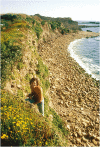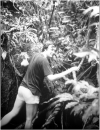Klaus Winter - the indefatigable CAM experimentalist
- PMID: 37010384
- PMCID: PMC10799999
- DOI: 10.1093/aob/mcad028
Klaus Winter - the indefatigable CAM experimentalist
Abstract
Background: In January 1972, Klaus Winter submitted his first paper on crassulacean acid metabolism (CAM) whilst still an undergraduate student in Darmstadt. During the subsequent half-century, he passed his Staatsexamensarbeit, obtained his Dr. rer. nat. summa cum laude and Dr. rer. nat. habil., won a Heinz Maier-Leibnitz Prize and a Heisenberg Fellowship, and has occupied positions in Germany, Australia, the USA and Panama. Now a doyen in CAM circles, and a Senior Staff Scientist at the Smithsonian Tropical Research Institute (STRI), he has published over 300 articles, of which about 44 % are about CAM.
Scope: I document Winter's career, attempting to place his CAM-related scientific output and evolution in the context of factors that have influenced him as he and his science progressed from the 1970s to the 2020s.
Keywords: Mesembryanthemum crystallinum; Biography; Klaus Winter; Smithsonian Tropical Research Institute (STRI); crassulacean acid metabolism (CAM); facultative CAM; inducible CAM.
© The Author(s) 2023. Published by Oxford University Press on behalf of the Annals of Botany Company.
Figures











Similar articles
-
Crassulacean acid metabolism (CAM) at the crossroads: a special issue to honour 50 years of CAM research by Klaus Winter.Ann Bot. 2023 Nov 25;132(4):553-561. doi: 10.1093/aob/mcad160. Ann Bot. 2023. PMID: 37856823 Free PMC article. No abstract available.
-
Possible roles for phytohormones in controlling the stomatal behavior of Mesembryanthemum crystallinum during the salt-induced transition from C3 to crassulacean acid metabolism.J Plant Physiol. 2021 Jul;262:153448. doi: 10.1016/j.jplph.2021.153448. Epub 2021 May 21. J Plant Physiol. 2021. PMID: 34058643
-
Effects of competition on induction of crassulacean acid metabolism in a facultative CAM plant.Oecologia. 2017 Jun;184(2):351-361. doi: 10.1007/s00442-017-3868-6. Epub 2017 Apr 11. Oecologia. 2017. PMID: 28401290
-
Facultative crassulacean acid metabolism (CAM) plants: powerful tools for unravelling the functional elements of CAM photosynthesis.J Exp Bot. 2014 Jul;65(13):3425-41. doi: 10.1093/jxb/eru063. Epub 2014 Mar 18. J Exp Bot. 2014. PMID: 24642847 Review.
-
The diverse diaspora of CAM: a pole-to-pole sketch.Ann Bot. 2023 Nov 25;132(4):597-625. doi: 10.1093/aob/mcad067. Ann Bot. 2023. PMID: 37303205 Free PMC article. Review.
Cited by
-
Atmospheric CO2 decline and the timing of CAM plant evolution.Ann Bot. 2023 Nov 25;132(4):753-770. doi: 10.1093/aob/mcad122. Ann Bot. 2023. PMID: 37642245 Free PMC article.
-
Crassulacean acid metabolism (CAM) at the crossroads: a special issue to honour 50 years of CAM research by Klaus Winter.Ann Bot. 2023 Nov 25;132(4):553-561. doi: 10.1093/aob/mcad160. Ann Bot. 2023. PMID: 37856823 Free PMC article. No abstract available.
References
-
- Adams WW, Diaz M, Winter K.. 1989. Diurnal changes in photochemical efficiency, the reduction state of Q, radiationless energy dissipation, and non-photochemical fluorescence quenching in cacti exposed to natural sunlight in northern Venezuela. Oecologia 80: 553–561. doi: 10.1007/BF00380081. - DOI - PubMed
-
- Atwell B, et al. 2021. Hank Greenway – an inspiring life (1926–2021). Phytogen. https://www.asps.org.au/archives/author/drkoerber/page/3. Accessed October 31, 2023.
-
- Bohnert HJ, Ostrem JA, Cushman JC, et al. 1988. Mesembryanthemum crystallinum, a higher plant model for the study of environmentally induced changes in gene expression. Plant Molecular Biology Reporter 6: 10–28. doi: 10.1007/bf02675305. - DOI
MeSH terms
LinkOut - more resources
Full Text Sources

